According to a 2012 report by Spa Alliance, Australia has the highest concentration of swimming pools per inhabitant. By 2018, according to research by Roy Morgan, 13% of Aussies, or about 2.7 million people, lived in a home with a pool.
It’s doubtful that Australia has toppled from its top spot since then. But among the remaining 87%, a few probably see their neighbour lounge lazily in the pool and wonder if they can afford to do the same.
Consider how much effort and money you can put into maintaining a pool before deciding to get one. And if the benefits of having a private pool, especially over the hot summer months, outweigh the costs and maintenance, you could get one.
Installing a pool is not guaranteed to increase your home’s resale value, so think twice before doing so. Prioritising your happiness while making this selection is essential because busy professionals may appreciate a pool less than young people.
This post will go through everything you need to know about building a swimming pool at your place. Let’s get started!
How Much Does Constructing A Pool Cost?
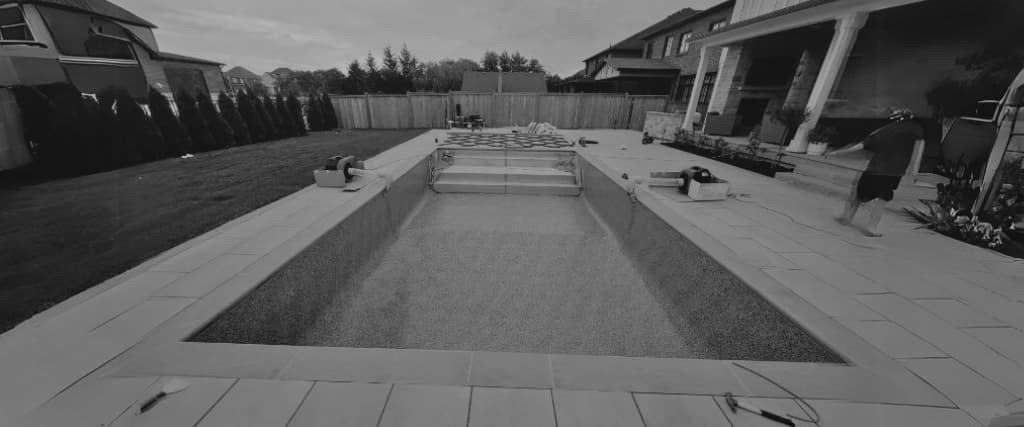
Swimming pools can cost thousands of dollars to build and require annual maintenance costs of up to $2,000.
Due to the high expense of excavation, in-ground pools, which are the most common, are also the most expensive. The typical price to install an inground concrete pool is around $50,000, closer to $35,000.
The average cost of an in-ground fibreglass swimming pool is between $25,000 and $75,000. Fencing, decking, and paving surrounding the pool can add several thousand dollars to these totals.
Different kinds of pools can be less expensive. In contrast to in-ground pools, which may cost upwards of $10,000, above-ground swimming pools can be purchased for far less. In most cases, however, they’re simpler to set up.
Costs for various swimming pool configurations, as provided by Airtasker, are detailed below.
Types of Swimming Pools You Can Have at Your Home
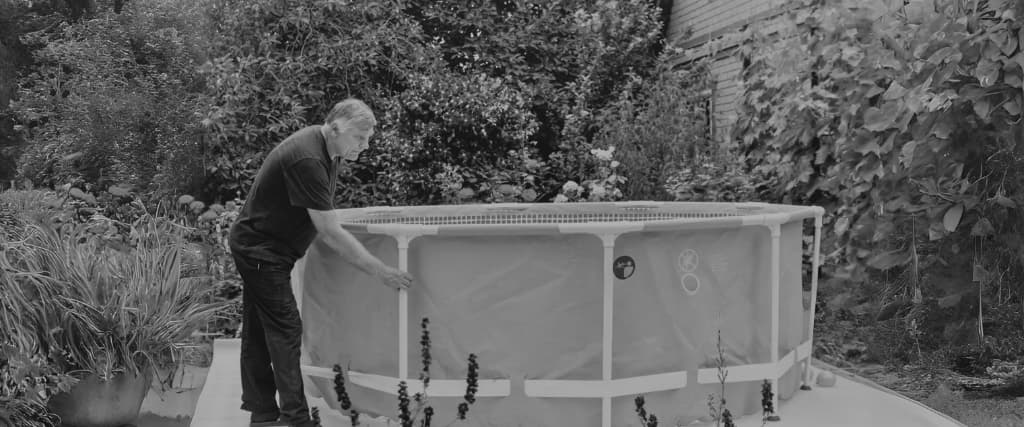
The best addition you can make to your house is a swimming pool. A pool’s function can range from calming retreat to a family fun zone to a serious swimmers’ training ground.
Different collections have different uses, costs, and building processes, so it’s essential to carefully consider your needs and those of your family before making a final decision.
Above-ground and specialised pools are all viable alternatives when planning for a pool. It’s important to remember that not all swimming pools are legal in all areas. Before beginning construction, make sure you have a thorough understanding of all applicable local building codes and safety regulations.
The following guides some of the most common kinds of swimming pools. There are advantages and disadvantages to each choice, as well as other factors to consider.
In-Ground Swimming Pool

In-ground pools are some of the most common swimming pools in Australia. These swimming pools can be constructed using fibreglass, vinyl, or concrete.
Concrete pools are more designer-friendly and generally more expensive to install. The fibreglass pools, on the other hand, are less costly to create but allow fewer options in design.
Fibreglass
Installation prices for fibreglass pools range from $45,000 to $70,000, as reported by Compass Pools. However, you shouldn’t take these numbers at face value because building price inflation is a common problem in the sector.
The fibreglass casing is often set up in a hole dug into the ground. Because of this, it is crucial to have easy access to the spot where you want the pool installed, and problems with getting to that spot from inside or outside your house can quickly drive up the cost.
Inaccessible backyards may necessitate using a crane to lower the pool from the roof of the house into the yard above ground level.
Furthermore, once you start excavating in the backyard, you may discover that the spot you meant to put the swimming pool has rock and roll, massive tree roots, or perhaps drainage systems. These considerations will swiftly determine the size and location of the pool.
Most fibreglass pools already exist in standard sizes and designs, limiting your options for customisation. Since fibreglass can still fracture and decay, the quality of the installation is a significant factor in determining the final cost.
DIY fibreglass pool systems can be purchased from companies like Compass Pools for around $20,000. Excavation and plumbing expenses are not included in this estimate. Compass advises against going the DIY route and instead hiring a professional builder and contractor.
Concrete
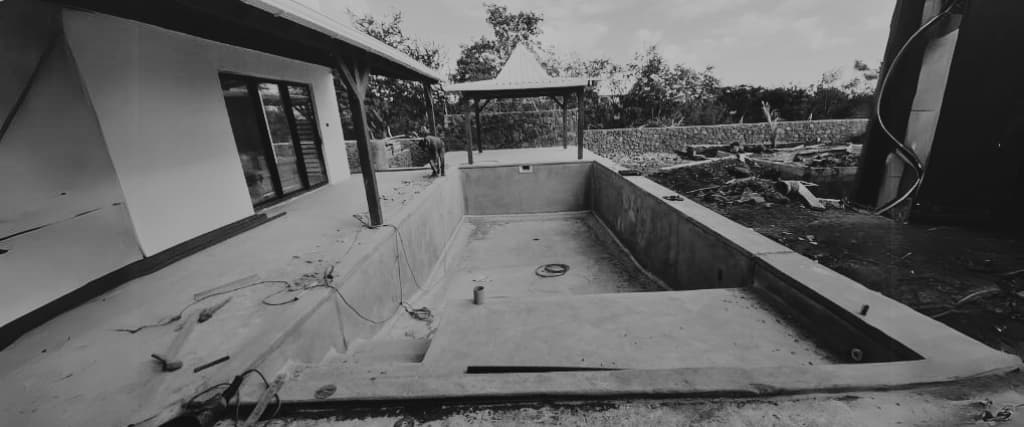
Compass Pools estimates that a concrete pool will cost between $25,000 and $30,000.
The most significant benefit of a concrete swimming pool is the ability to customise its appearance to complement the rest of your property. Concrete allows for significantly more flexibility in terms of design, but the need for a price cap makes it impractical in many situations.
Costs associated with labour and setup will vary depending on factors such as pool size, yard accessibility, and soil condition.
Vinyl
These concrete-bottomed pools have panel walls assembled on-site and then connected. After that, a vinyl liner was created to order wraps around the entire pool.
Advantages of In-Ground Swimming Pools
With an in-ground pool, you can design your ideal pool in terms of its dimensions, form, and design. The primary benefits are as follows:
- The form and size of your yard are not a limiting factor when it comes to in-ground pools, and neither is the depth you require for diving or workout swimming.
- They may be seamlessly integrated into landscape designs.
- Diving panels, slides, water activities, water fountains, and decorative lighting are some extras that can be added to your pool.
Downsides of In-Ground Swimming Pools
There are a few significant drawbacks to this style of pool as well:
- It’s more common to find higher prices for in-ground pools.
- The length of time required for building varies.
- In-ground pools are more dangerous for small children and pets as the water’s surface is so close to the ground.
Above-Ground Swimming Pool
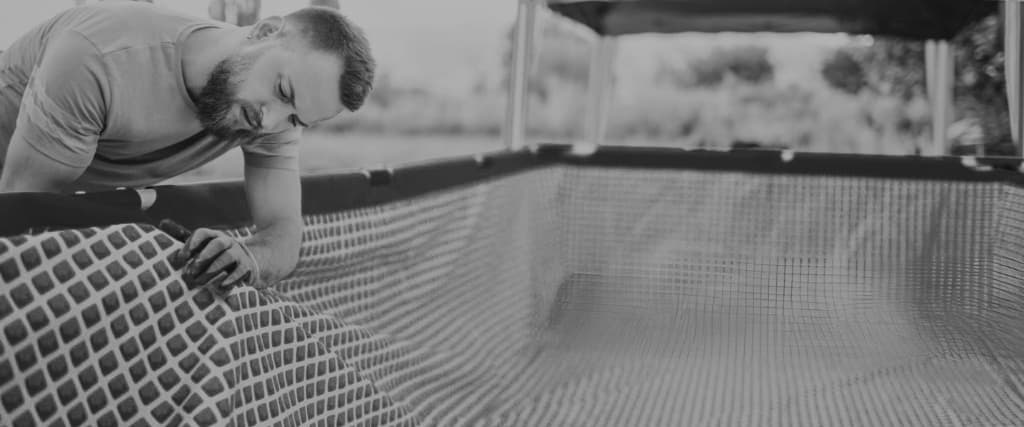
the Above-ground pools are less expensive than in-ground pools yet have a shorter shelf life. However, they are easier and cheaper to install.
Remember that above-ground swimming pools can be replaced with in-ground swimming pools at any time; most Australian above-ground homeowners have done that, according to Compass Pools.
You can find options in the $50 price range at retailers like Bunnings and Kmart. Inflatable or transportable alternatives costing less than $2,000 can also be found at pool supply businesses. Above-ground pools made of modular or vinyl units are an excellent long-term investment.
Modular Swimming Pools

Unlike traditional in-ground pools, modular swimming pools eliminate the need to dig up your property forever. They are readily available in a wide range of sizes and forms. Depending on the features and size, they cost anything from $20,000 to $41,000 or more, but thanks to their ‘plug and play’ nature, installation is typically a breeze, as stated by Compass Pools.
You can save time and money by not digging up your yard to install one of these pools on a natural slope or hill. Your design and fabric options will set the final price tag. Compared to an above-ground vinyl swimming pool, the lifespan of a modular pool is far longer, and the maintenance needed is much lower.
Vinyl Swimming Pools
Vinyl swimming pools are a long-lasting choice that won’t break the bank. The cost of constructing an Above-ground vinyl swimming pool is estimated at $10,000. These pools’ linings are less robust and more quickly damaged than concrete or fibreglass options, with an anticipated five to ten-year lifespan.
If a vinyl pool is ever severely damaged, it might have to be redone. Above-ground pools are cheaper than regular pools because of the time and money they save on installation.
Advantages of Above-Ground Swimming Pools
The materials and labour required to construct an above-ground swimming pool are much lower than in-ground pools. Some of the primary benefits include the following:
- The most cost-effective option is an above-ground pool.
- You can pack up and carry a few choices because they are temporary structures.
- They come in various sizes and forms, making them ideal for urban gardens.
- An above-ground swimming pool’s assembly and disassembly are child’s play.
Disadvantages of Above-Ground Swimming Pools

These drawbacks of above-ground pools should also be taken into account:
- They come in various sizes and forms, but you’re usually stuck with whatever the manufacturer offers regarding aesthetics.
- Above-ground pools are notoriously hard to conceal in landscaping, but well-designed decks and terraces can help.
- They don’t last as long as permanent pools installed in the ground. Every five years, your vinyl liner will need to be replaced.
Above-ground swimming pools, especially the simplest models that can be filled with a hose from the garden and put away while not in use, are also quite common. Since no filtration system is needed, they must be emptied, sanitised and refilled continuously to maintain a healthy swimming area.
3. Infinity Swimming Pools
Infinity swimming pools have walls that appear to disappear into the water and are ideal for showcasing a vista. In this way, water can trick the eye into thinking it has no limits as it flows over the wall.
This pool style is frequently installed on sites with a dramatic drop-off, allowing bathers to take in breathtaking panoramas of the surrounding mountains, ocean, lakes, or other natural wonders. Infinity pools are notoriously expensive to construct and keep up with because of their intricate designs.
4. Lap Pools
A lap pool can be a good investment if exercise is the primary motivation for getting a pool. Generally rectangular, this style of in-ground pool was developed with lap swimming in mind. Lap pools are perfect for cramped backyards because of their compact design.
The requirement for frequent turns is reduced by the fact that most lap pools provide a minimum of 40 feet of uninterrupted swimming space. The minimum acceptable width of a swimming pool for one swimmer is eight feet. As with any in-ground pool, there are a few things to remember throughout construction.
5. Swim Swimming Spas
Another form of the pool that works well for fitness purposes. Swim spas, a cross between a pool and a hot tub, feature water jets that make swimming against a steady current possible.
Some swim spas are as few as 12 feet long, making them ideal for tight backyards. Since the swimmer isn’t propelling themselves through the water, a pool of lesser size is sufficient. They can be warmed for use as a swim spa and a spa.
Ongoing Costs of Pools
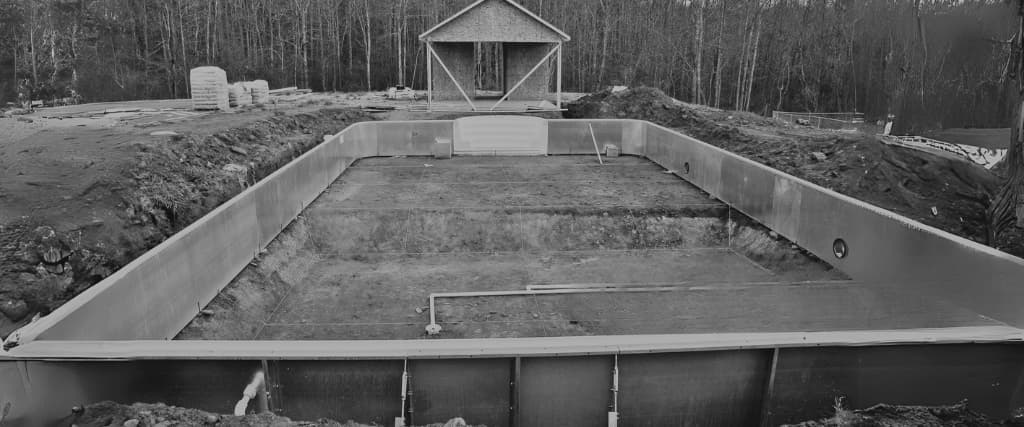
Fencing
Swimming pools can cost thousands of dollars to build and require annual maintenance costs of up to $2,000.
Due to the high expense of excavation, in-ground pools, which are the most common, are also the most expensive. The typical price to install an inground concrete pool is around $50,000, closer to $35,000.
The average cost of an in-ground fibreglass swimming pool is between $25,000 and $75,000. Fencing, decking, and paving surrounding the pool can add several thousand dollars to these totals.
Different kinds of pools can be less expensive. In contrast to in-ground swimming pools, which may cost upwards of $10,000, above-ground swimming pools can be purchased for far less. In most cases, however, they’re simpler to set up.
Costs for various swimming pool configurations, as provided by Airtasker, are detailed below.
- Channels
- Handrails
- Gate latch
- Gate panels
- Gate hinges
- Fence posts
- Fence panels
You may expect a price somewhere about.
- Costs range from $ 200 to $ 350 per metre for a treated pine wood slat fence.
- A wrought iron fence can cost between $450 and $600 for every linear metre.
- Pool fencing made of semi-frameless glass might cost $200 to $275 for every linear metre.
- Frameless glass fencing can cost between $275 and $600 for every linear metre.
The typical Australian pool is 9 metres in length and 4 metres in width. It could cost as much as $5,000 to install a glass fence around this pool, allowing for adequate clearance on both sides. Although some alternative materials may be less expensive, they will almost always increase your overall installation expenses.
Maintenance
The maintenance costs for a fibreglass pool are typically the lowest. After installing your fibreglass pool, a service technician buff the coating above the water level. However, you won’t have to worry about bacterial buildup or repainting.
More chemicals are needed to keep a concrete pool clean and microorganisms-free. The surface could lose its waterproofing and require more frequent maintenance. Above-ground swimming pools with vinyl lining are more high-maintenance than their fibreglass. According to Compass Pools, the shell must be relined after a decade.
Remember that the tools and chemicals required to maintain a swimming pool can add up quickly. Maintenance expenses for a pool include things like a pool vacuum, filter, heater, and additives like saltwater or chlorine. Think about whether you’ll need any special chemicals or gear to clean your pavement, deck, or other surfaces that surround your pool.
Cutting on Maintenance Cost
It is tempting to decrease expenditures on routine maintenance for the pool to cut costs. However, according to Nic Brill, CEO of Poolwerx, paying attention to the swimming pool almost always results in costly repairs down the road.
Mr Brill remarks that skipping pool maintenance schedules is an excellent way to save money in the short term. However, it’s important to remember that pools can’t be “turned off” and that regular maintenance is the best way to avoid costly repairs in the future.
However, several items help reduce pool operating costs. They include:
Pool Cover
Water loss from evaporation in an open swimming pool can increase to 10,000 L per month. This results in the loss of chemicals and water, which must be replenished to maintain equilibrium. According to Poolwerx, a cover can reduce water loss by 99.84%. A mask can also aid in heat retention and lower energy costs.
Solar Heating
Using Solar panels is among the most cost-effective solutions to heat your pool. The pump moves pool water through the heated tubes on the roof until it attains the desired temperature. Solar panels can generate up to four times the power of a heating system on a sunny day.
Variable Speed Pumps
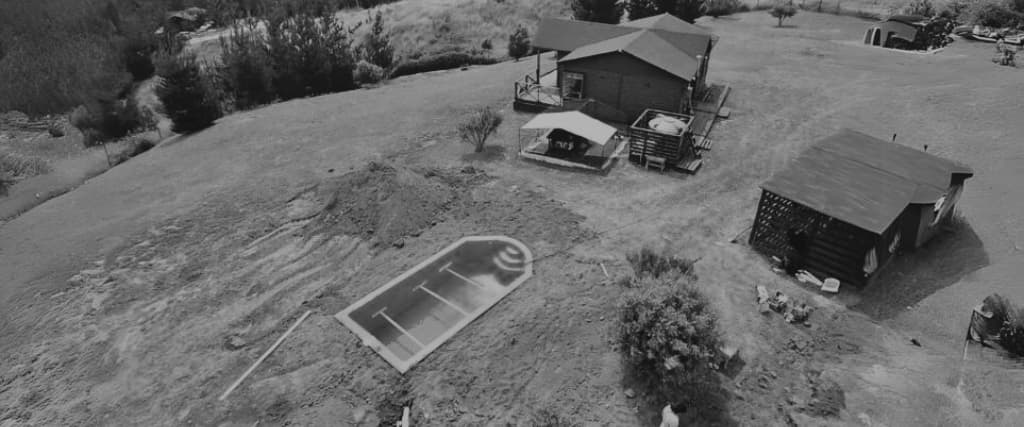
A household with a swimming pool can anticipate that the pump will account for around 18% of power usage. According to Poolwerx, this is too high since most individuals use single-speed pumps, which are much less effective than those with variable speeds.
Over 50% of pool owners polled still used single-speed pumps, according to a pool pump study by the DEE (the Department of Environment and Energy).
The reduced initial cost is the primary factor that leads consumers to choose the inferior product. Still, as Poolwerx points out, the upfront cost of the pump only represents around 20% of the full price, with the remaining 80% coming from electricity bills over time.
According to the estimates, employing variable-speed pumps calibrated explicitly to the pool’s cleaning, filtration, and sanitation needs will save you more than $750 a year on energy costs.
Can a Pool Improve Value of a Property?
A swimming pool in the backyard may increase the asking price when selling the property. This is ultimately determined by how much the buyer appreciates a pool.
Those who don’t fancy a pool will negatively view it as money and time-consuming. On the other hand, pool enthusiasts will greatly appreciate the value of a property if it has a pool.
What else influences how a pool’s worth is as follows:
Climate
The climate is the main factor in determining a swimming pool’s worth. The sunny weather is likely to make a pool an appealing feature for buyers, and depending on one’s sensitivity to cold, people living in the country’s northern areas can use a pool virtually all year round.
Roy Morgan reports that one in every five Australians now has a private pool in their backyard, with 19% of Perth people, 18% of Brisbane residents, and 15% of Sydney residents doing so.
These numbers matter because they highlight the regions where potential buyers place the most importance on a pool. A pool will only increase your home’s worth and desirability if you reside in the South.
Beachside Properties
Many homebuyers put a premium on being close to the water. Those ready to splurge on a beachfront property may also appreciate the added amenity of a swimming pool.
According to Michele Levine, CEO of Roy Morgan, pool ownership is more common in coastal areas. It shouldn’t come as a surprise that Australians residing in the warmer areas are more likely to have swimming pools than those in the South.
This is evident as Queenslands’ Gold Coast and Sunshine Coast comprise 20% of the national population owning pools.
Poolside Family Baberque
The neighbourhood demographics in which the home is located, climate, and location will affect the value pool adds to the property.
A family may purchase your property in a desirable location, such as a safe neighbourhood accessible to public transportation and schools. Roy Morgan’s research demonstrates that Australian households with children highly value swimming pools.
Socioeconomic status and the existence of kids in the household also play a role in determining whether a specific home will have a swimming pool and the weather.
Among Australian families, over 17% have children between the ages of 6 and 11, and this number rises to barely over 23% among those with children aged 12 to 15 (a 3% rise in four years).
What to Consider Before Installing a Swimming Pool?

Putting in a swimming pool in your backyard is a fun plan. Here are a few things to think about when estimating the price of your pool:
Reasons for having a pool. Whether you want a pool for physical activity and wellness training or family fun is a significant factor in your decision. Consider installing an old-fashioned in-ground pool for fun and relaxation with your loved ones. A lap pool is The largest pool for working out and getting in shape.
Your budget. What kind and how big of a pool you can afford to have built depends heavily on your financial situation. Consider how much you can spend overall, then break it into categories like excavation, installation, materials to be utilised based on design choices, gardening, and ongoing costs of maintaining the swimming pool, including gear and chemicals.
Dimensionality. The first step is determining what kind of pool you want and how big it should be. Think about the entire space available, where in the yard you’d like to put the pool, how often you plan to use it, and how many people will use it. You’ll need a deeper and more spacious pool to swim laps.
In-ground or above-ground pools. You’ll need to select right from the bat whether you want an above-ground or in-ground pool. This choice is essential since it will affect the construction of your pool from start to finish. Because of their more permanent appearance, in-ground pools are more popular than their above-ground counterparts. However, excavation is a costly undertaking.
It’s set up a time! It could take as long as three months to build a pool. You can get started if you receive the necessary permits and approvals from the local government. Remembering construction time will increase proportionally with the pool’s complexity is essential.
Preferences of the Council. Get the OK from the city government before breaking ground on your pool. Before purchasing a pool, make sure to research the local ordinances concerning such things as fencing requirements. The local government must also approve the pool’s blueprints and technical details.
The builder/contractor. Find a reliable contractor or builder to ensure a safe pool installation. You need to hire a reliable contractor. The best place to start is with personal recommendations from someone you trust. Talking to multiple contractors and thinking about their experience level is also intelligent. Verify that they have insurance, and remember to ask about guarantees.
Other Swimming Pool Types You Can Consider
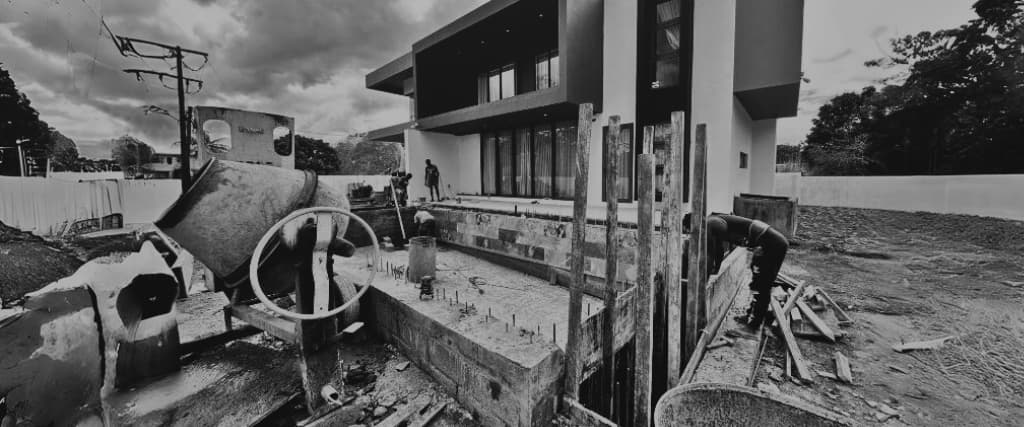
Any structure capable of holding water, whether permanent or temporary, can be considered a swimming pool in the context of home landscaping. There’s a wide variety available, so it’s essential to consider how your family will use the pool before making a purchase.
“swimming pool” encompasses many products, from highly affordable portable toys for kids to multi-million dollar landscape elements.
What kind of pool you have built or installed on your property will depend on several factors, including your budget, the size of your land, building regulations in your area, and the accessibility of necessary supplies. Also, think about how much upkeep is involved with each option.
Some people who purchase pools with extensive upkeep need to regret their decision.
Consider what you desire and require from a pool, as well as the time, funds, and work you are willing to put in, as you browse the following options.
Kiddie Pool
The inexpensive range begins with the ubiquitous portable kiddie swimming pool, which comes in the form of an inflatable unit or a hard plastic casing, depending on your preference.
These pools may be stored away during the colder months and brought out when the weather gets warm enough for the youngsters to require a place to cool off.
Even a shallow pool can be dangerous to unattended children, so be careful to drain it after use and keep a close check on the youngsters at all times.
If you wait until the end of a season, you can save up to 75% on a kiddie swimming pool, bringing the price down to just a few dollars. This more cost-effective choice can meet your primary motivation for wanting a pool. And no pool requires less upkeep.
Indoor Swimming Pool
Simply said, indoor pools are enclosed by a wall (at least) and protected from the elements by a roof. Indoor swimming pools are constructed in basic geometric shapes so that swimmers and athletes of all ages can use them year-round, even in colder climates.
A typical indoor swimming pool consists of an in-ground swimming pool (an average of $55,000) enclosed by a glass cover (cost: $10,000-$30,000). A similar enclosure can be built around an above-ground pool.
Indoor heated swimming pools can sometimes be more cost-effective than outside counterparts. The indoor pool’s superior heat retention over outdoor pools results from its secure location. Additionally, the enclosure eliminates the need to constantly remove leaves and other debris from the pool.
Olympic-Size Pool
It’s ideal for those with much room and money to spend and serious about getting in shape.
Swimming at the Olympic level is one of the most-watched sports, with thousands of events and athletes from hundreds of countries participating.
Unsurprisingly, the Olympic Games would inspire ambitious swimmers and swimming enthusiasts to long for their Olympic-sized pool.
However, constructing an Olympic-sized pool can be a demanding task. Construction of a certified Olympic pool requires at least $300,000, must have dimensions of 25 meters in width and 50 meters in length, and hold 500,000 gallons or more. If you own a pool like this, you should employ a pool service to help with the routine upkeep.
Architectural Pool
The term “architectural pool” pretty much gives it all away; these pools are planned out, have clean lines, and typically mimic the shape of a home and employ the same materials.
A pool with the design of architectural features is typically geometric, high-end, and created by an architect. If the home is custom-built, the pool is generally constructed concurrently, with consideration given to the shape of the lot and how it will ultimately affect the pool’s placement.
These kinds of pools can afford to have architects build them. Such pools may quickly increase the price of a property by $100,000 or more; therefore, they are typically factored into the overall master design for the residence and landscape. Routine procedures should be followed to keep the pool clean and the water balanced.
Natural Pool
Self-cleaning natural pools incorporate swimming areas with water beds. Rubber or solidified polyethylene is used to line the majority of natural pools. Aquatic landscaping provides an organic purification system installed in the pool’s designated “regeneration” region.
A natural pool can be created in a freeform, natural form with stones and streams, or it may be constructed in a contemporary or architectural fashion, sleek and attractive, just like any in-ground domestic swimming pool.
Depending on the landscape, natural pools might be as expensive as or more so than traditional pools. Gardeners like them because of the wide range of plants that may be cultivated; environmentalists and those who don’t like swimming in chlorine water also find them appealing.
These pools are typically simple to maintain as long as the surrounding environment is stable, although this is only sometimes the case. Algae growth and improper water chemistry make restoring a pool to its original condition difficult, if not impossible.
Spool
A spool is a combination of the terms spa and pool. Water catchment areas smaller than regular pools yet larger than standard spas have been increasingly popular among homeowners in the past few years, particularly those on limited budgets and smaller homes.
As an area to soak and chill off on scorching days or have guests for drinks on lovely evenings, a spool is a popular amenity for many households. You may swim against the current of a spool’s directed jets.
Some pools are poured concrete structures set into the ground, but most are formed from an extensive spa or whirlpool shell on a raised platform. Spool outfitting might cost between $5,000 and $20,000. Smaller pools are easier to maintain than larger ones, but you’ll still have to monitor the water chemistry and the filter equipment.
Caution: Some spools meet the criteria for standard swimming pools and are, therefore, legal. Protective fences and adherence to other regulations may be necessities in your area.
Saltwater Pool
Saltwater swimming pool, ocean pool, isn’t a pool style but an alternate way of filtering and purifying for swimming pools that gained popularity in Australia and Nz for many years before spreading to other continents.
These pools employ saltwater chlorine generators to disinfect the water and kill bacteria and algae. In either case, adding a few critical components can transform a regular pool into a generator pool.
As long as it is designed for above-ground swimming pools, salt-water chlorine generators can likewise be installed in an above-ground swimming pool.
Routine cleaning of the pool’s walls and filter gear is required for maintenance, just like with chlorinated pools.
Plunge Pool
Plunge swimming pools are tiny, cold-water pools utilised in Chinese medicine for thousands of years. After a hot training, sauna, or spa treatment, many swimmers and athletes like cooling off in a pool of chilly water.
Plunge pools come in two flavours: standalone and as an add-on to an existing in-ground pool. They may give the impression of being a regular spa, but a careful toe dip will disclose the truth.
The Cost of Concreting Your Swimming Pool?
Concrete pools stay long, may be shaped any way you like, and are robust. However, the upfront costs and construction times are higher than other pool options.
The going rate for a 7m by 3m concrete pool is between $50,000 and $65,000. A 12m by 5m pool might run you $75,000 to $85,000. Costs range between $35,000 and $40,000 for a smaller pool with dimensions of 6 m by 3 m. A larger pool may set you back at least $100,000.
In most cases, the pool’s size will determine the cost. All dimensions and attributes are included here. Since larger pools require more room, they cost more than their smaller counterparts. Challenges with accessibility or construction could impact the final price tag. Heating costs may also be included in estimates by some contractors.
If you’d like a few more amenities for the pool, they will cost more money overall. Adding these amenities can increase your pool’s visual attractiveness, but you should be prepared to pay for it.
Spending an extra $13,000–$15,000 on customisations is possible. You’ll need at least $2,000 more to create a waterfall. Mosaic tiling can cost anywhere between $14,000 and $19,000. The price per square meter for a complete width step entry is $600. It could cost around $370 to add a seating area to the pool.
Average coping costs are $32 per meter at 300 millimetres, $92 per meter at 400 millimetres, and $155 per meter at 500 millimetres. The stepping is the cover that goes around the outside of the pool to protect it. It keeps the pool’s lining safe from the corrosive effects of water and debris.
Cost of Constructing Fibreglass Swimming Pool
Fibreglass pools are defined by their “one-piece” shell construction. These are formed using a mould and produced in a factory before being shipped. This style of in-ground pool is less expensive than a concrete pool and requires less upkeep.
The final cost of your fibreglass pool will depend on several things. The size and design of the pool shell, the ease with which the site can be excavated, the desired level of integration with the surrounding landscape, and the availability of suitable equipment all play a role.
A fibreglass pool shell can range between $6,500 and $25,000, but the cost of installation (setting the pool cover on previously excavated dirt) is at least $10,000.
The final sum may include the cost of pool accessories. The average price for a 1.5 horsepower pool pump is around $700. Pool cleaners that can scale walls cost between $289 and $665, and self-cleaning chlorinators cost between $450 and $1,099.
Pavers made of concrete can be purchased for $40–$65 per square meter, brick pavers for $70–$95, limestone pavers for $45–$75 per square meter, and pavers made of flagstone, travertine, and granite for $70–$100 per square meter. The price per square meter of decking can vary from $200 to $1,000, depending on the materials used.
To sum up, a fully completed fibreglass pool can cost between $20,000 and $40,000 and even up to $50,000 with elaborate extras and landscapes.
Cost of Constructing a Vinyl Liner Swimming Pool?
Swimming pools with vinyl liners have a thick vinyl sheet between the water and the pool’s frame. Vinyl liner pools have much cheaper upfront expenses than fibreglass or concrete pools.
Above-ground vinyl-liner pools typically cost between $10,000 and $35,000. Investing in pool fencing is also necessary to conform to building codes.
A vinyl-lined in-ground swimming pool, on the other hand, can cost anywhere between $20,000 and $70,000. The vinyl liner in this style of pool only lasts about five to ten years, and replacing it will cost you between three thousand and six thousand dollars.
Cost of Constructing an Above-Ground Swimming Pool?
Due to the lack of excavation and the homeowner may install an above-ground swimming pool, it is a more cost-effective option than a traditional in-ground pool. Depending on size and materials, a fixed above-ground swimming pool may cost between $10,000 and $20,000.
Above-ground pools necessitate a large, flat area in the backyard to function correctly so that you may save money on decking, pavement, and landscaping. It is also essential to include pool accessories and fencing in the price.
Cost of a Pool Safety Inspection
Pools must comply with stringent safety rules imposed by state and local governments. For this reason, you must also get your pool inspected for safety by a certified pool inspector.
Your pool’s safety inspection cost may vary based on the type of pool fence you have installed and other considerations. The price range for a thorough safety inspection of a private pool is $175 to $450.
An additional examination is necessary and costs about $120 if the first one reveals that adjustments are needed to meet the rules. There may be an increase of up to $750 for large or shared pools.
A pool safety permit can be yours for between $30 and $35 if your pool satisfies all the requirements.
Running cost of Swimming Pool?
A swimming pool’s price tag continues beyond the initial investment. Including the regular upkeep and fees associated with keeping the pool sanitary and functional is essential. Maintenance entails using chemicals, a swimming pool pump, and frequent maintenance.
The typical annual expense for upkeep of a swimming pool is $1,000. The price tag rises or falls with factors including pool size, shape, and whether or not it is roofed. The constituent parts here are:
- Operating a pool pump costs between $80 and $110 monthly.
- Chemicals costing $200 annually
- Cleaning services cost anywhere from $50 to $1,000.
- Costs between $100 and $1.5k annually for heating
The Alternatives to Swimming Pools
A swimming spa is a fantastic replacement for a traditional pool. Spa amenities, portability, and ease of installation are just a few of the many advantages of these pools compared to conventional swimming pools.
“swim spa” refers to a hybrid of the two concepts. They’re a one-stop shop for health and wellness, with a hydrotherapy section and strong swim jets.
With a swim spa, you may enjoy a resort’s soothing and rejuvenating effects while still getting a good workout. In addition, you receive much more for your money because these pools are made to be heated and enjoyed all year round.
Swim Spa vs Swimming Pool Running Costs
Most pool owners close their facilities for the winter months and only use them in the summer when they are not heated.
Unlike other types of pools, swim spas can be utilised whenever you like. They are heated by either the spa’s internal heater or, more efficiently, a separate spa heat pump outdoors.
Most pools, as we’ve seen, aren’t heated and are meant to be used primarily during the summer, whereas swim spas are operational all year long. To understand where you stand financially, compare winter heating prices for the pool and the swim spa.
Remember that operating costs will differ depending on variables, including where you live, the weather, how often and how you utilise the swim spa, and how large the swim spa is.
If you live in a mild environment like Sydney and use your swim spa twice or thrice a week during the winter, heating the water with a heat pump will add roughly $100 to $200 to your monthly electricity cost, on average.
In contrast, the monthly expense of heating a pool during the cold months may exceed $1,000.
In Summary
The final price tag for constructing a pool will vary widely based on the desired pool’s design, location, size, materials, and any additional features you might want.
Consider the price of repairs and upkeep as well. After all, the expense of having a pool does not stop with the initial investment. It’s essential to look at how much other amenities, like swim spas, would cost in addition to a swimming pool. A smaller, more adaptable swim tub or a plunging pool could save you a lot of money.
This post has highlighted the many angles from which to view pool installation. If the initial investment required to build a pool prevents you from doing so, there are other ways to enjoy water recreation that keeps the bank intact.